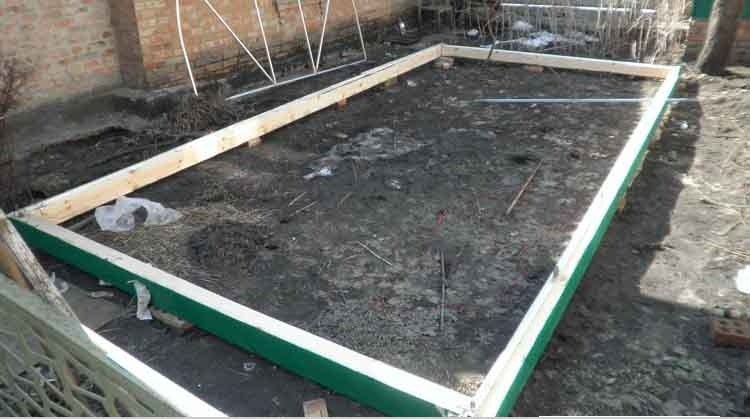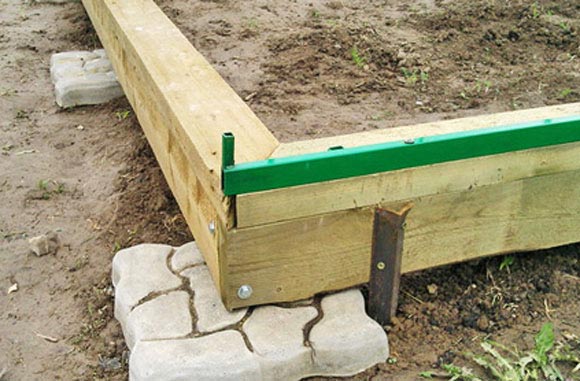How to build a polycarbonate greenhouse foundation
Content
What is it for
It is better to install a greenhouse made of light and solid polycarbonate on a reliable base, although theoretically you can do without it. Why, in this case, do you need a foundation that you can really do with your own hands? Its functions are considered to be reliable fixation of the frame of the structure, insulation of its walls from touching the ground - up to 10% of the heat can escape from the inside of the building through its surface.

The foundation still prevents unwanted frost and fog from entering the middle of the greenhouse. They can pose a serious threat to the normal growth and development of vegetable crops. A DIY polycarbonate greenhouse foundation is an excellent solution for creating a barrier to pests - moles and other shrews.
Foundation options
For reliable fastening of the structure, you can choose one of the existing foundation options, which is easy to do with your own hands if desired. If you build a greenhouse without a foundation, it can not only squint after the first winter due to ground movement... The material is capable of cracking, the doors will become difficult to open and close, and outwardly the structure will look inappropriate. What foundation for a greenhouse can you make with your own hands? Experts identify such types as block, brick, lumber or wood, monolithic, point. Craftsmen make another economical option - from glass bottles.
Video "Installation of the foundation in the greenhouse"
Monolithic

If you decide to create with your own hands a reliable and solid foundation that will protect the structure from the effects of frost and penetration of pests, you need a monolithic foundation. It is recommended for soils with an unstable surface, since it is a costly measure. It is poured under non-separable greenhouses, which will be used in the winter. To make a slab foundation with your own hands, you need to dig a pit 10 cm larger than the size of the future greenhouse. Its depth is up to 30 cm. Inside the pit is lined with geotextile, along the edges there is a wooden formwork so that it rises 20 cm above the earth's surface. Sand is poured and compacted somewhere in 10 cm, moistened with water. Next comes a layer of gravel about 5 cm, a reinforcing mesh is laid over it.
The pit is poured with concrete mortar, smoothing and leveling the base. The concrete will "set" after about an hour. After that, anchor bolts are placed around the perimeter, placing them on the line of the base of the future frame. It is necessary to wait a few days for everything to dry out. The concrete is periodically moistened - it is permissible to put wet rags on top so that the solution does not dry out too quickly. Before the foundation is poured, experts recommend making a drain system in the center - this way, moisture will not accumulate on the concrete surface during the use of the greenhouse.
Tape

This kind of foundation, which you can really do with your own hands on a personal plot, will be a universal solution. The tape-type foundation is well suited not only for a polycarbonate greenhouse and will help out in any construction. To create this reinforced concrete MZF, a trench is dug, the depth of which is 400 mm, and the width is 200 mm. The bottom should be covered with sand, with a layer of up to 200 mm. Its compaction and leveling is carried out with available tools, spilling water in the course of work. Formwork is being installed, which is covered with plastic wrap from the inside for protection.
So when pouring concrete, the water will not go into the sand, that is, the normal water-cement ratio will remain. The reinforcement cage is knitted, for the creation of which 4 long rods with a diameter of up to 8 mm are used. To form a structure of the required volume, take another 8 short rods. The concrete solution is being poured. If necessary, glasses are provided for the installation of the greenhouse. To reduce the height of the reinforced concrete base, it is permissible to use a brick. When choosing this option, the order of work is as described above.
With a wooden base

If you are not interested in the long service life of the future greenhouse and there is no way to invest a lot of money in the construction of the foundation, we recommend creating an inexpensive wooden foundation with your own hands.
The timber is an affordable and popular material. If the greenhouse is small, the weight of the frame made of a metal profile will be suitable, the foundation from a bar will be able to withstand such a load. Even if the wood is pretreated with special means, the service life of such a foundation will not be more than 7 years, in rare cases up to 10 - if expensive deciduous timber is used.
For him, a bar with a square section is better suited - 150 by 150 mm in size. The base for the greenhouse will consist of 4 beams. At the beginning of work, a trench is dug around the perimeter of the future structure. Its depth should be about 200 mm. The bottom of the pit must be covered with sand, with a layer of 100 mm. It should be tamped normally and the resulting surface should be leveled. Before laying the timber in the trench, it must be waterproofed. For this, bituminous mastic is used - it will serve as a reliable protection against ingress and unwanted effects of moisture. The bars are placed in the trench, their elements are securely fastened with screws and corners.
Video "Foundation for a greenhouse"
What if you need to build a foundation for the construction of a greenhouse? Don't miss the next video, where you will find answers to many questions.
